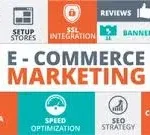
How to starting an online store in 2025 presents a lucrative opportunity for entrepreneurs to tap into the expanding e-commerce market. With the right strategy, you can establish a successful online business that caters to a global audience. Here’s a comprehensive guide to help you launch your online store this year.

1. Identify Your Niche and Target Audience
Begin by selecting a niche that aligns with your interests and market demand. Choosing a niche you’re passionate about will keep you motivated, while ensuring there’s a market for your products will drive profitability. Utilize tools like Google Trends to assess the popularity of potential niches over time. Once you’ve identified your niche, define your target audience by considering factors such as age, gender, location, and purchasing behavior. Understanding your audience will guide your product selection and marketing strategies.
razorpay.com
2. Conduct Market Research
Examine your rivals to determine their advantages and disadvantages. Examine their product offerings, pricing strategies, and customer reviews to identify gaps in the market that your store can fill. This research will help you position your products effectively and develop unique selling propositions that set your store apart.
sellfy.com
3. Choose Your Products
Decide whether you’ll sell physical or digital products. Physical products require inventory management and shipping logistics, while digital products, such as e-books or online courses, can be delivered electronically, reducing overhead costs. Ensure that your products meet quality standards and fulfill the needs of your target audience.
sellfy.com
4. Select an E-commerce Platform
Select a trustworthy e-commerce platform based on your company’s requirements. Popular options include Shopify, WooCommerce, and BigCommerce. Consider factors such as ease of use, customization options, payment gateways, and scalability when making your decision. A user-friendly platform will streamline the process of setting up and managing your online store.
razorpay.com
5. Register a Domain Name and Set Up Hosting
Choose a domain name that accurately captures your brand identity and is memorable. Ensure it’s easy to spell and pronounce to enhance brand recall. After securing your domain, choose a reliable hosting provider that offers fast loading speeds and minimal downtime, as these factors significantly impact user experience and search engine rankings.
razorpay.com
6. Design Your Online Store
Create an attractive and intuitive website design that provides a seamless shopping experience. Use high-quality images and detailed product descriptions to showcase your offerings. Because a large percentage of customers purchase on mobile devices, be sure your website is responsive. Implement clear navigation menus and a straightforward checkout process to reduce cart abandonment rates.
forbes.com
7. Set Up Payment and Shipping Options
Integrate secure payment gateways to facilitate smooth transactions. Offer multiple payment methods, such as credit cards, digital wallets, and bank transfers, to accommodate customer preferences. Partner with reliable shipping providers to ensure timely and safe delivery of physical products. Clearly communicate shipping policies, costs, and delivery times to manage customer expectations.
razorpay.com
8. Implement SEO Strategies
Improve your website’s search engine optimization to boost exposure and draw in natural traffic. Conduct keyword research to identify terms your target audience is searching for, and incorporate them naturally into your product titles, descriptions, and meta tags. Ensure your website has a clean URL structure, fast loading times, and is free from technical errors that could hinder search engine crawling.
forbes.com
9. Launch Marketing Campaigns
Promote your online store through various marketing channels to drive traffic and generate sales. Utilize social media platforms to engage with your audience, share content, and run targeted ads. Consider influencer partnerships to expand your reach. Implement email marketing campaigns to nurture leads and encourage repeat purchases. Offering promotions, discounts, or referral programs can also incentivize customers to choose your store over competitors.
bigcommerce.com
10. Monitor and Optimize Performance
Regularly analyze your store’s performance using analytics tools to track metrics such as traffic sources, conversion rates, and customer behavior. Use this data to identify areas for improvement and make informed decisions. Continuously update your product offerings, website design, and marketing strategies based on customer feedback and market trends to stay competitive.
razorpay.com
By following these steps, you can establish a thriving online store in 2025 that meets the needs of your target audience and stands out in the competitive e-commerce landscape.










